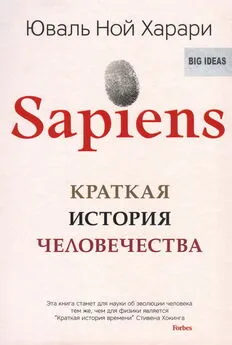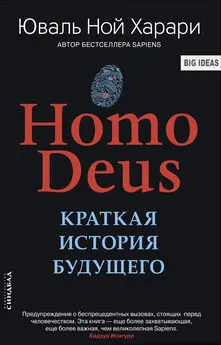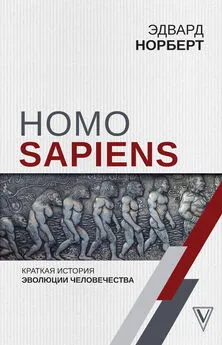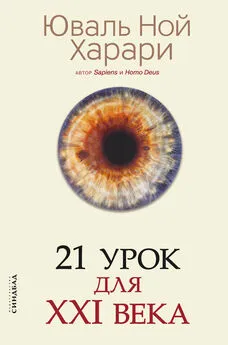Юваль Ной Харари - Homo Deus. Краткая история будущего
- Название:Homo Deus. Краткая история будущего
- Автор:
- Жанр:
- Издательство:Синдбад
- Год:2018
- Город:Москва
- ISBN:978-5-906837-92-9
- Рейтинг:
- Избранное:Добавить в избранное
-
Отзывы:
-
Ваша оценка:
Юваль Ной Харари - Homo Deus. Краткая история будущего краткое содержание
Что произойдет, когда Google и Facebook будут лучше, чем мы сами, знать наши вкусы, личные симпатии и политические предпочтения? Что будут делать миллиарды людей, вытесненных компьютерами с рынка труда и образовавших новый, бесполезный класс? Как воспримут религии генную инженерию? Каковы будут последствия перехода полномочий и компетенций от живых людей к сетевым алгоритмам? Что должен предпринять человек, чтобы защитить планету от своей же разрушительной силы?..
Главное сейчас, полагает Харари, – осознать, что мы находимся на перепутье, и понять, куда ведут пути, простирающиеся перед нами. Мы не в силах остановить ход истории, но можем выбрать направление движения.
Homo Deus. Краткая история будущего - читать онлайн бесплатно ознакомительный отрывок
Интервал:
Закладка:
110
John F. Cyran, Rita J. Valentino and Irwin Lucki, ‘Assessing Substrates Underlying the Behavioral Efects of Antidepressants Using the Modifed Rat Forced Swimming Test’, Neuroscience and Behavioral Reviews , 29:4–5 (2005), 569–574; Benoit Petit-Demoulière, Frank Chenu and Michel Bourin, ‘Forced Swimming Test in Mice: A Review of Antidepressant Activity’, Psychopharmacology 177:3 (2005), 245–255; Leda S. B. Garcia et al.,‘Acute Administration of Ketamine Induces Antidepressant-like Effects in the Forced Swimming Test and Increases BDNF Levels in the Rat Hippocampus’, Progress in Neuro-Psychopharmacology and Biological Psychiatry 32:1 (2008), 140–144; John F. Cryan, Cedric Mombereau and Annick Vassout, ‘Te Tail Suspension Test as a Model for Assessing Antidepressant Activity: Review of Pharmacological and Genetic Studies in Mice’, Neuroscience and Behavioral Reviews 29:4–5 (2005), 571–625; James J. Crowley, Julie A. Blendy and Irwin Lucki, ‘Strain-dependent Antidepressant-like Efects of Citalopram in the Mouse Tail Suspension Test’, Psychopharmacology 183:2 (2005), 257–264; Juan C. Brenes, Michael Padilla and Jaime Fornaguera, ‘A Detailed Analysis of Open-Field Habituation and Behavioral and Neurochemical Antidepressant-like Efects in Postweaning Enriched Rats’, Behavioral Brain Research 197:1 (2009), 125–137; Juan Carlos Brenes Sáenz, Odir Rodríguez Villagra and Jaime Fornaguera Trías, ‘Factor Analysis of Forced Swimming Test, Sucrose Preference Test and Open Field Test on Enriched, Social and Isolated Reared Rats’, Behavioral Brain Research 169:1 (2006), 57–65.
111
Marc Bekof, ‘Observations of Scent-Marking and Discriminating Self from Others by a Domestic Dog ( Canis familiaris ): Tales of Displaced Yellow Snow’, Behavioral Processes 55:2 (2011), 75–79.
112
Подробнее о разных уровнях самосознания см.: Gregg, Are Dolphins Really Smart? , 59–66.
113
Carolyn R. Raby et al., ‘Planning for the Future by Western Scrub Jays’, Nature 445:7130 (2007), 919–921.
114
Michael Balter, ‘Stone-Throwing Chimp is Back – And This Time It’s Personal’, Science , 9 May 2012, accessed 21 December 2014,http://news.sciencemag.org/2012/05/stone-throwing-chimp-back-and-time-its-personal; Sara J. Shettleworth, ‘Clever Animals and Killjoy Explanations in Comparative Psychology’, Trends in Coginitive Sciences 14:11 (2010), 477–481.
115
Gregg, Are Dolphins Really Smart? ; Nicola S.Clayton, Timothy J. Bussey, and Anthony Dickinson, ‘Can Animals Recall the Past and Plan for the Future?’, Nature Reviews Neuroscience 4:8 (2003), 685–691; William A. Roberts, ‘Are Animals Stuck in Time?’, Psychological Bulletin 128:3 (2002), 473–489; Endel Tulving, ‘Episodic Memory and Autonoesis: Uniquely Human?’, in The Missing Link in Cognition: Evolution of Self-Knowing Consciousness , ed. Herbert S. Terrace and Janet Metcalfe (Oxford: Oxford University Press), 3–56; Mariam Naqshbandi and William A. Roberts, ‘Anticipation of Future Events in Squirrel Monkeys ( Saimiri sciureus ) and Rats ( Rattus norvegicus ): Tests of the Bischof-Kohler Hypothesis’, Journal of Comparative Psychology 120:4 (2006), 345–357.
116
I. B. A. Bartal, J. Decety and P. Mason, ‘Empathy and Pro-Social Behavior in Rats’, Science 334: 6061 (2011), 1427–1430; Gregg, Are Dolphins Really Smart? , 89.
117
Karl Krall, Denkende Tiere: Beiträge zur Tierseelenkunde auf Grund eigener Versuche (Leipzig: F. Engelmann, 1912).
118
Christopher B. Ruf, Erik Trinkaus and Trenton W. Holliday, ‘Body Mass and Encephalization in Pleistocene Homo’, Nature 387:6629 (1997), 173–176; Maciej Henneberg and Maryna Steyn, ‘Trends in Cranial Capacity and Cranial Index in Subsaharan Africa During the Holocene’, American Journal of Human Biology 5:4 (1993), 473–479; Drew H. Bailey and David C. Geary, ‘Hominid Brain Evolution: Testing Climatic, Ecological, and Social Competition Models’, Human Nature 20:1 (2009), 67–79; Daniel J. Wescott and Richard L. Jantz, ‘Assessing Craniofacial Secular Change in American Blacks and Whites Using Geometric Morphometry’, in Modern Morphometrics in Physical Anthropology: Developments in Primatology: Progress and Prospects , ed. Dennis E. Slice (New York: Plenum Publishers, 2005), 231–245.
119
См. также: Edward O. Wilson, Te Social Conquest of the Earth (New York: Liveright, 2012).
120
Cyril Edwin Black, ed., Te Transformation of Russian Society: Aspects of Social Change since 1861 (Cambridge, MA: Harvard University Press, 1970), 279.
121
NAEMI09, ‘Nicolae Ceauşescu LAST SPEECH (english subtitles) part 1 of 2, 22 April 2010, accessed 21 December 2014, http://www.youtube.com/watch?v=wWIbCtz_Xwk.
122
Tom Gallagher, Tef of a Nation: Romania since Communism (London: Hurst, 2005).
123
Robin Dunbar, Grooming, Gossip, and the Evolution of Language (Cambridge, MA: Harvard University Press, 1998).
124
TVP University, ‘Capuchin monkeys reject unequal pay’, 15 December 2012, accessed 21 December 2014, http://www.youtube.com/watch?v=lKhAd0Tyny0.
125
Цит. по: Christopher Dufy, Military Experience in the Age of Reason (London: Routledge, 2005), 98–99.
126
Serhii Ploghy, Te Last Empire: Te Final Days of the Soviet Union (London: Oneworld, 2014), 309.
127
Время сновидений – термин, введенный этнографом Адольфусом Питером Элкином и обозначающий общее для всех австралийских аборигенов представление о своеобразной мифологической эре, эпохе творения, продолжающей существовать в потусторонней реальности.
128
Fekri A. Hassan, ‘Holocene Lakes and Prehistoric Settlements of the Western Fayum, Egypt’, Journal of Archaeological Science 13:5 (1986), 393–504; Gunther Garbrecht, ‘Water Storage (Lake Moeris) in the Fayum Depression, Legend or Reality?’, Irrigation and Drainage Systems 1:3 (1987), 143–157; Gunther Garbrecht, ‘Historical Water Storage for Irrigation in the Fayum Depression (Egypt)’, Irrigation and Drainage Systems 10:1 (1996), 47–76.
129
Yehuda Bauer, A History of the Holocaust (Danbur: Franklin Watts, 2001), 249.
130
Jean C. Oi, State and Peasant in Contemporary China: Te Political Economy of Village Government (Berkeley: University of California Press, 1989), 91; Jasper Becker, Hungry Ghosts: China’s Secret Famine (London: John Murray, 1996); Frank Dikkoter, Mao’s Great Famine: Te History of China’s Most Devastating Catastrophe, 1958–1962 (London: Bloomsbury, 2010).
131
Martin Meredith, Te Fate of Africa: From the Hopes of Freedom to the Heart of Despair: A History of Fify Years of Independence (New York: Public Affairs, 2006); Sven Rydenfelt, ‘Lessons from Socialist Tanzania’, Te Freeman 36:9 (1986); David Blair, ‘Africa in a Nutshell’, Telegraph , 10 May 2006, accessed 22 December 2014, http://blogs.telegraph.co.uk/news/davidblair/3631941/Africa_in_a_nutshell/.
132
Roland Anthony Oliver, Africa since 1800 , 5th edn (Cambridge: Cambridge University Press, 2005), 100–123; David van Reybrouck, Congo: Te Epic History of a People (New York: HarperCollins, 2014), 58–59.
133
Ben Wilbrink, ‘Assessment in Historical Perspective’, Studies in Educational Evaluation 23:1 (1997), 31–48.
134
M. C. Lemon, Philosophy of History (London and New York: Routledge, 2003), 28–44; Siep Stuurman, ‘Herodotus and Sima Qian: History and the Anthropological Turn in Ancient Greece and Han China’, Journal of World History 19:1 (2008), 1–40.
135
William Kelly Simpson, The Literature of Ancient Egypt (Yale: Yale University Press, 1973), 332–333.
136
Естественные права – права, которыми люди обладают от природы, то есть без каких-либо договоренностей или при отсутствии каких-либо политических или юридических институтов. Их нужно отличать от позитивных прав, которые гарантирует конкретная правовая система.
137
C. Scott Dixon, Protestants: A History from Wittenberg to Pennsylvania, 1517–1740 (Chichester, UK: Wiley-Blackwell, 2010), 15; Peter W. Williams, America’s Religions: From Teir Origins to the Twenty-First Century (Urbana: University of Illinois Press, 2008), 82.
138
Glenn Hausfater and Sarah Blafer, ed., Infanticide: Comparative and Evolutionary Perspectives (New York: Aldine, 1984), 449; Valeria Alia, Names and Nunavut: Culture and Identity in the Inuit Homeland (New York: Berghahn Books, 2007), 23; Lewis Petrinovich, Human Evolution, Reproduction and Morality (Cambridge, MA: MIT Press, 1998), 256; Richard A. Posner, Sex and Reason (Cambridge, MA: Harvard University Press, 1992), 289.
139
Ronald K. Delph, ‘Valla Grammaticus, Agostino Steuco, and the Donation of Constantine’, Journal of the History of Ideas 57:1 (1996), 55–77; Joseph M. Levine, ‘Reginald Pecock and Lorenzo Valla on the Donation of Constantine’, Studies in the Renaissance 20 (1973), 118–143.
140
Смысл существования ( фр .).
141
Gabriele Boccaccini, Roots of Rabbinic Judaism (Cambridge: Eerdmans, 2002); Shaye J. D. Cohen, From the Maccabees to the Mishnah, 2nd edn (Louisville: Westminster John Knox Press, 2006), 153–157; Lee M. McDonald and James A. Sanders, ed., The Canon Debate (Peabody: Hendrickson, 2002), 4.
142
Sam Harris, Te Moral Landscape: How Science Can Determine Human Va l u e s (New York: Free Press, 2010).
143
Ковенант (от англ. covenant ) – соглашение, договор. В религиозном контексте: торжественное, священное соглашение между Богом и человеком.
144
Gerald S. Wilkinson, ‘The Social Organization of the Common Vampire Bat II’, Behavioral Ecology and Sociobiology 17:2 (1985), 123–134; Gerald S. Wilkinson, ‘Reciprocal Food Sharing in the Vampire Bat’, Nature 308:5955 (1984), 181–184; Raul Flores Crespo et al., ‘Foraging Behavior of the Common Vampire Bat Related to Moonlight’, Journal of Mammalogy 53:2 (1972), 366–368.
Читать дальшеИнтервал:
Закладка:





![Жак Аттали - Краткая история будущего [Мир в ближайшие 50 лет]](/books/1076384/zhak-attali-kratkaya-istoriya-buduchego-mir-v-blizhajsh.webp)
![Юваль Ной Харари - 21 урок для XXI века [Версия с комментированными отличиями перевода]](/books/1080711/yuval-noj-harari-21-urok-dlya-xxi-veka-versiya-s-ko.webp)

![Юваль Ной Харари - Sapiens. Краткая история человечества [litres]](/books/1102059/yuval-noj-harari-sapiens-kratkaya-istoriya-cheloveche.webp)

